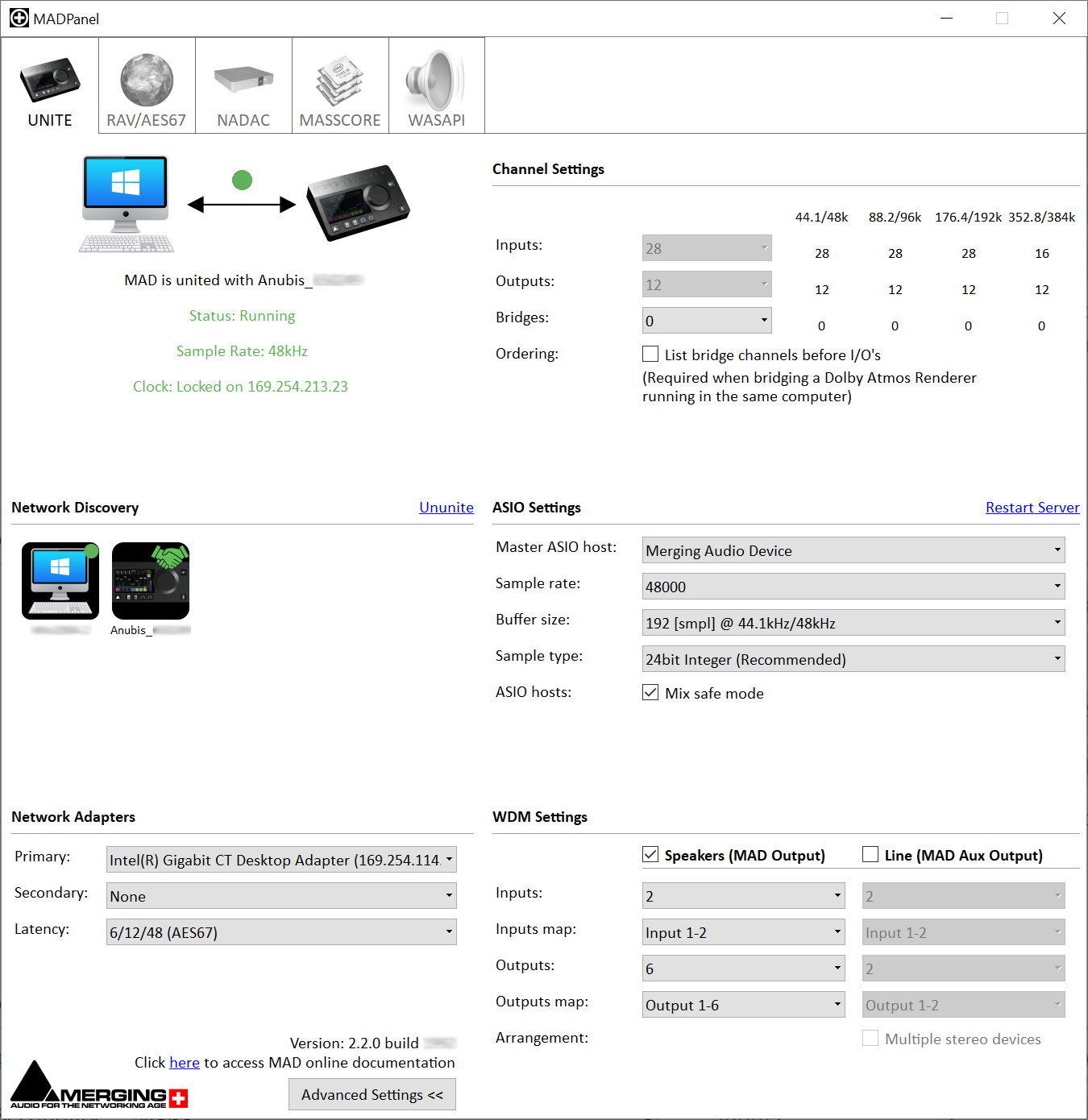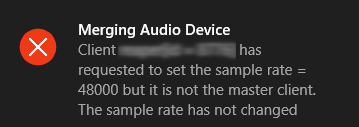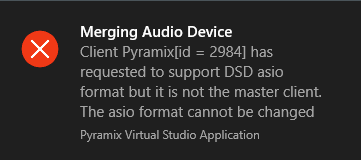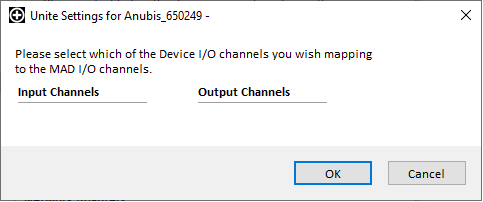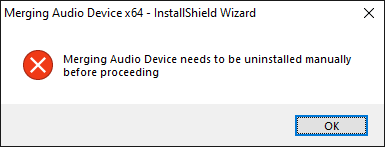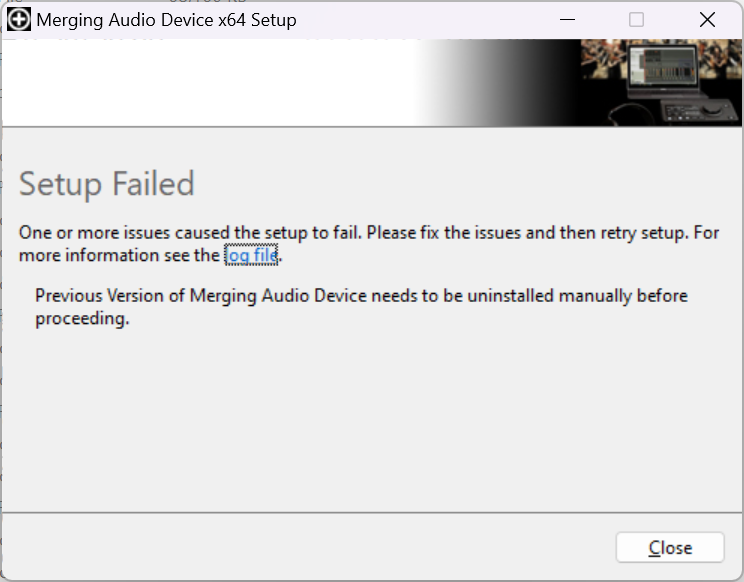Merging Audio Device driver Troubleshooting.
Merging Audio Device ASIO driver can connect to third party AES67 / RAVENNA devices, but a Merging device must be present on the network (PTP clock)
The Driver has been tested and qualified on Windows 10 & 11 Professional 64 bit.
Windows 8/8.1 is not supported.
Windows 32bits versions are not supported.
Install - Uninstall issues
To upgrade MAD, it is mandatory to remove the installed MAD version before installing the new one. In some cases, the uninstall process doesn't work, preventing the upgrade to the new version.
- Go in Windows Task Manager (CTRL + SHIFT + ESC) Services Tab and stop the Merging Audio Device Server (MADSrv) and the Merging Technologies RAVENNA ASIO Driver Service (RavennaASIOSrv).
- Browse to C:\Program Files\Merging Technologies\Merging Audio Device and delete the remaining content of the folder.
You may have to provide administrator rights to do so. - Download and run this Microsoft tool
https://support.microsoft.com/en-us/topic/fix-problems-that-block-programs-from-being-installed-or-removed-cca7d1b6-65a9-3d98-426b-e9f927e1eb4d - Select Uninstalling, then select Merging Audio Device x64 from that listing and remove it.
- Reboot the computer
- Install the new MAD version.
In some rare cases, the drivers may have to be removed as well
Advanced users only Windows restore point or Backup is recommended before you follow the procedure.
- With MAD uninstalled, download DriverStoreExplorer Zip file https://github.com/lostindark/DriverStoreExplorer/releases/latest
- Extract the zip file in any convenient place and run Rapr.exe with administrator rights.
- Browse the list and select mergingravennaasiodriver.inf - madsoundemuks.ing - madsoundemubus.inf
- Click on Delete Drivers
- If the drivers can't be removed, tick the "Force Deletion" checkbox, and Delete Drivers again.
- Reboot the computer
- Install the new MAD version.
Uninstaller stuck on Processing: Merging Audio Device x64
The uninstaller is stuck on Merging Audio device x64
- Go in Windows Task Manager (CTRL + SHIFT + ESC) Details Tab
- Select the MADSrv.exe process and click on End Task.
The uninstall process should now resume.
When selecting your Network adapter in MAD Panel, you get an error message "Unable to bind to this network adapter"
- Make sure Windows User Account Control is set to the lowest value (Never Notifiy)
Go in Windows Control Panel > User accounts > Select your user account > click on Change User Account Control settings and set it to "Never Notify"
You must reboot for this change to apply - Make sure you are using a compatible Windows version :
Windows 10 64 bits
For details, please see the Merging Audio Device Operating System compatibility page - Make sure you have selected a 1GB ethernet adapter
- Make sure you have selected a network adapter with a valid IP address (if the IP address displayed is 0.0.0.0, it is not possible to bind to it).
- Update your network adapter driver
You can connect inputs between the RAVENNA/AES67 device and MAD, but outputs stays orange in ANEMAN
Verify the Windows Firewall
- If you are using Windows Firewall, go in Windows Control Panel > Windows Firewall.
The first possibility is to turn the firewall off for the kind of network you use for RAVENNA Network (default and direct connection is Public Network). If you use a dedicated network, disabling the firewall for this network is quite safe.
If the RAVENNA network is not isolated or if you are worried about security, make sure your application is authorized to communicate through the firewall.
The Merging Audio Device panel is already authorized in the built-in Windows Firewall, but you also have to allow your application(s), in Windows Control Panel > Windows Firewall : Allow an app or feature. - If you have an antivirus installed, make sure it does not have its own firewall, and disable it or configure it to allow your application(s).
- If your firewall is correctly configured or disabled, refer to the Troubleshooting section of ANEMAN User Manual for further help.
The audio inputs and outputs are distorted
- In MAD Panel, please increase the buffer size and click on Apply.
Usually, 384 samples for the 6/12/48(AES67) latency or 256 for the 16/32/64 latency is a good starting point. - Make sure the Latency set in your RAVENNA device is set accordingly to the one in the MAD Panel (64 or 48 Samples).
- Performance issue : With only 1 DAW running on your computer, disconnect all your IO in ANEMAN , set the MAD Panel to use 8 in and 8 out, and set the sampling rate to 44.1.
Connect the headphone, or another convenient low track count monitoring ; if you don't have anymore clicks, set more I/O in ANEMAN and MAD panel to determine how many channels your system can handle.
Usually, slow or dual core CPU are rather subject to this kind of issue - Performance issue : make sure you don't use power management features in Windows.
Go in Windows Control Panel > Power Options and select "High Performance" power plan. - DPC Latency issue : some computer drivers or devices may interrupt your CPU process, which can result in distortion, glitches or drops.
Please see our DPC Latency helper page for details. - Realtek 2.5GbE Network Controllers : the default Receive Buffers value is often set to 512 by default. Please set it to 256 (Transmit Buffers should be left to 512).
Please go in the Windows Device Manager, and access the Network Adapters > Realtek 2.5GbE controller Properties - Advanced tab to set the Receive Buffers to 256. - In MAD Panel, make sure you don't have a "Network Throttling" error message (reboot your computer in such case).
Windows can automatically reduce the network bandwidth on some specific process.
The MAD installer turns off this option automatically, but if for any reason this option has been turned on, you may disable Network Throttling on your system, by downloading, unzip and launch this patch : DisableNetworkThrottling.zip
“Merging Audio Device service is not running”
- Click on (start service), this should force the service to start.
- The service should run automatically when your computer starts.
Please go in Windows Control Panel\Administrative Tools\Services.
Access the Merging Audio Device Server Properties, and verify that Startup Type is set to Automatic. - Although the MAD service should run without Administrator rights, if your Windows User account has restrictive access, please see with your IT administrator that you have sufficient rights to run such service.
MAD does not start properly at Windows startup - Restart Server required
On some specific systems (usually on Windows Server or Virtual Machines), right after Windows startup, MAD is not running properly (e.g No ASIO Host, ASIO Clock Missing,...). A manual "Restart Server" is required.
This happens if the system and the selected network adapter are not fully initialized when MAD starts.
To avoid this issue, it is possible to delay MAD startup, with a registry key.
Please download MADStartupDelay.zip, unzip and follow the instructions in the README file.
“ASIO clock missing; is there an audio device properly configured on the network”
No compatible RAVENNA/AES67 devices have been detected
- Please check the IP adresses, your ASIO network card and the RAVENNA device(s) must be in the same range.
If your Merging RAVENNA/AES67 device is configured to use its default IP addresses, it will be 169.254.xxx.xxx, then your Native network adapter have to be in the same range 169.254.xxx.xxx
If the default IP address (Auto) is used in the your Merging RAVENNA/AES67 device, your network card have to be set to use an automatic IP address. - If you have several network adapters, make sure that the other networks are NOT in the same IP range, Windows is not able to handle 2 networks with the same range.
If the RAVENNA network is using the 169.254.xxx.xxx range, your other network(s) should for example be set to 192.168.xxx.xxx.
For further help on IP addresses, please see this page. - MAD requires to have a Merging RAVENNA/AES67 device on the network, for clocking. This Merging RAVENNA/AES67 device must be the PTP Master (clock icon in ANEMAN), but no additional audio connections are required (unless you are running in NADAC mode).
- Make sure the Merging PTP Master device has its ASIO Clock setting to Auto or On
Horus/Hapi : Setup > System > ASIO Clock.
Anubis : Settings > General : Clock - ASIO Clock. - If this happens always after a cold boot of the computer (not after a restart), please make sure you have disabled the Windows "Fast Startup" feature.
Go in Windows Control Panel > Power options.
Click on "Choose what the power buttons do" on the left hand pane.
Click on "Change settings that are currently unavailable" and untick the "Turn on fast startup" option.
“ASIO clock sample rate (xxkHz) doesn't match driver's sample rate (xxkHz)”
Sampling rate in the DAW and on the RAVENNA network do not match.
- Set your DAW sampling rate as the RAVENNA/AES67 device/network one, or set the device /network sample rate as the DAW one.
- If you have several DAW running, make sure all are running at the same sampling rate.
See also the Master ASIO host setting in MAD Panel :
(Default) Any running application may change the driver sampling rate. If you set a specific application, only this application can change the driver sampling rate (if it is running). - In ANEMAN, you can create a Sample Rate zone and set your DAW as sampling rate Master (crown icon), so all devices in this zone will follow the sampling rate.
- If you have several devices on the same RAVENNA network, make sure the PTP Master is set to the same sampling rate as the ASIO driver.
“ASIO Clock error : latency of the master audio device and ASIO driver must be set accordingly"
The latency of the ¨MAD driver and the master Merging RAVENNA/AES67 device do not match.
- Change the Latency setting in the ASIO Panel : 64(32/16) or AES67 (48/12/6)
- Or change the Latency setting in Horus/Hapi Setup > System page.
Or in Settings > General > Latency in Anubis devices. - Make sure your Horus or Hapi device is running firmware 3.9.4 (or above)
If your Horus or Hapi device is running a version prior to V3.9.4, please use the legacy ASIO driver V11.
Anubis firmware is compatible with MAD (or legacy ASIO driver v12, but not previous ASIO driver versions)
“no ASIO Host connected”
No DAW is using the ASIO driver.
- Make sure your DAW is running and set to use the Merging Audio Device driver.
- Close all the ASIO Hosts, and click on Restart Server in the MAD panel.
“No Master ASIO Host selected”
Master sampling rate application not set
Please set a Master ASIO application. This application will be the ASIO driver sampling rate master. If the Master is started, other application won't be allowed to change the sampling rate.
If left to Default, any application can change the sampling rate any time.
This list is dynamically populated, the first time you start an application set to use the Merging Audio device, it will be added to the list
- Start your audio application, and configure it to run with Merging Audio Device driver.
Go in Merging Audio Device panel, you can now select the application in the Master ASIO host drop down menu.
Click on Apply once set.
WDM Section is grayed out in the Merging Audio Device Panel and can't be accessed
Sampling rate not supported by the MAD - WDM driver.
See the "Driver" sampling rate in the Status section, if the sampling rate is DSD, then the WDM driver is automatically disabled.
It will be enabled automatically when the Driver Sampling rate is set back to PCM or DXD.
Audio glitch / drop when starting a second application using MAD driver.
When you start a second application, the Mixing Mode may need to be adjusted, see the Mix Safe Mode option:
- If the Mix Safe Mode is checked, then the MAD will always introduce one latency to perform the multiple applications mixing safely.
- If the Mix Safe Mode is unchecked then the MAD will have no latency when only one application is connected.
It will have one latency when a second applications is connected to perform the multiple applications mixing.
In such case, a transition is required to perform the latency change, which can cause a glitch when you start a second application.
Playback in my DAW hangs / stuck.
- At least 1 Merging RAVENNA device must be present in your setup (for clocking, see ASIO clock missing error message above)
- Make sure the Network latency is set accordingly between the MAD driver and the Master device (see ASIO Clock error : latency error message above)
- Make sure that your DAW and Merging RAVENNA devices sampling rates matches (see ASIO clock sample rate error message above)
- In MAD panel, check that the Sample rate value is correct according to your settings, and that the State is running.
- If you have several applications running, make sure all are set on the same sampling rate, or define a Master ASIO host in the MAD panel.
No audio on the MAD Bridge inputs or outputs
- Depending on your sampling rate, make sure you have set enough Bridge channels in the MAD Panel
- Verify the audio routing in your DAW. Bridge IO are labelled as MAD Bridge.
- WDM : verify in the MAD panel the WDM inputs and/or outputs channel maps.
“Unable to init ASIO driver : Merging Audio Device” when starting Pyramix -
Unable to start / initialize the ASIO driver when starting your DAW -
"Merging Audio Device service is not running" error message.
The MAD service is not running.
- Open the Windows Task Manager (CTRL+ALT+Del), go in the Services tab.
Make sure the MAD - Merging Audio device Service is running.
If the service state is "Stopped", right click on it and select Start.
If the service state is "Stopping" or "Starting", go in Task Manager Details tab, select MADSrv.exe and click on End Task. Once the task is stopped, go back in the Services tab to start the MAD - Merging Audio Device Service. - Make sure your Antivirus is not preventing the MAD service to start.
- If your Windows User account has restrictive access, please see with your IT administrator that you have sufficient rights to run such service.
- If you still can't start the MAD service and you have just installed it (and have rebooted the computer as requested by the installer), please uninstall the Merging Audio Device driver, reboot your computer then re-install it.
“The Driver is not properly configured" error message -
VS3 Control Panel sampling rate, inputs and outputs all shows 0
Driver configuration.
- If you have just installed the Merging Audio Device driver, you have to first configure it., please go in the Merging Audio Device panel.
Adapter not properly configured -
"NIC adapter not available or not properly configured" error message
The Ethernet adapter is not set or not available
- Go in the Merging Audio Device panel and make sure you have selected am Ethernet adapter.
- If you had previously set an Ethernet adapter, make sure it is still available / enabled.
- Verify that the selected Ethernet adapter has a valid IP address (not 0.0.0.0)
If your Merging RAVENNA/AES67 device is directly connected to the Ethernet adapter, make sure it is turned on and that the cable is correctly plugged. - If you have several network adapters, make sure that the other networks are NOT in the same IP range, Windows is not able to handle 2 networks with the same range.
If the RAVENNA network is using the 169.254.xxx.xxx range, your other network(s) should for example be set to 192.168.xxx.xxx.
For further help on IP addresses, please see this page.
Client has requested to set the sampling rate, but it is not the master client. Sampling rate has not changed.
You have set a Master ASIO host in the MAD control panel, and another application is trying to change the sampling rate.
- Set the Master ASIO host and the other applications at the same sampling rate.
- You may also close the Master ASIO host application if you don't need it anymore, and redo the sampling rate change in the other application.
When you will restart the Master application, of course the sampling rate will be set by this application again.
“RavennaASIODriver error: wrong version”
The panel and driver versions are not the same.
- There was a previous version that was not properly uninstalled (including the previous Merging RAVENNA ASIO driver)
Please go in Windows Programs & Features page, and uninstall any instance of Merging Audio Device x64 and Merging RAVENNA ASIO driver x64. You must reboot the computer once uninstalled.
Once rebooted, browse to C:\Windows\System32\drivers and make sure MergingRavennaASIODriver.sys is NOT present. Then re-install the MAD driver.
If MergingRavennaASIODriver.sys is present, rename the file to MergingRavennaASIODriver.xxx (Windows administrator rights are mandatory). Reboot one more time and re-install the MAD driver.
WDM (Windows Audio) not working
- In the Merging Audio Device panel, make sure the "Speakers" or "Line" box is ticked.
Please press on Apply to confirm. - In the Merging Audio Device panel, please check the WDM inputs / outputs map, it must be routed to the channels you are listening to.
Please press on Apply to confirm. - Go in Windows Control Panel > Sound and make sure that the Merging Audio Device is your default device in the Playback and Recording tabs, depending on your requirements.
Alternatively, if your Windows Audio application allows it, make sure the Merging Audio Device is selected as your playback / recording device.
If you are using MAD WDM Speakers (Main), please select the MAD Speakers device and click on the Configure button to apply a speaker layout. - On some systems, the speakers layout is not properly recalled by Windows (after a computer restart for example). This issue is currently under investigation.
In such case, the user should reapply the speakers layout in Windows Control Panel > Sound Control Panel. - Configure. - Merging Audio Device WDM audio is currently not compatible with DSD sampling rates, please set a lower sampling rate in such case.
Merging Audio Device not available as Windows sound device.
- In the Merging Audio Device panel, make sure that the Speakers (MAD Output) or Line (MAD Aux output) is enabled.
Please press on Apply to confirm. - Go in Windows Control Panel > Sound or Windows Settings > System > Sound and check that the Merging Audio Device is not disabled.
The NMOS / Lawo Home tab is not displayed in the ASIO advance page
- Merging Audio Device version 2.2.4 (or above) required for Lawo Home compatibility.
- Authorization keys are required to enable the NMOS and Lawo Home features.
Please make sure the required authorization keys are present in the MT Security panel (Dongle or Cloud licensing tab, depending on your licensing method)
Cannot set the sampling rate to DSD
DSD Sampling rates have some restrictions, as many ASIO host do not handle DSD at all. Therefore, when Merging Audio Device is set as Master ASIO Host, DSD sampling rates are not accessible.
The MAD - WDM bridge also do not handle DSD sampling rates.
- Go in the Merging Audio Device panel, and set your ASIO host as Master ASIO Host.
Then set the sampling rate from your ASIO DAW.
“Client has requested to support DSD ASIO format but it is not the master client. The ASIO format cannot be changed”
DSD Sampling rates can only be set by the Master ASIO Host.
- Go in the Merging Audio Device panel, and set your ASIO host as Master ASIO Host.
Then set the sampling rate from your ASIO DAW.
Hapi MKII not displayed in MAD Discovery
- Verify that you run MAD 1.0.6 HotFix and higher.
If you need to update it, please first uninstall the Merging Audio Device driver and reboot your computer before installing the updated version.
Please download from https://www.merging.com/support/downloads - If your MAD version is compatible, please se this page.
“Adapter(s) IP has changed. Please Rester Server" (ST2022-7 mode only)
ST2022-7 Mode only. The IP address of the adapter(s) has been changed.
- The IP address of at least one of the adapters has been manually changed, which requires a restart of the ASIO driver.
Press Restart Server.
Note: If the IP address is set to 0.0.0.0 (e.g. network cable unplugged), the ASIO driver does not require a reset, and will not ask you to restart the server.
Unite mode - MAD is not united to any device
You have not yet united the MAD driver to any device.
- Please connect your Merging device to your computer, select the network adapter it is attached to and Unite the device.
- For more details please see this page.
United failed - Cannot connect to IP address
You try to unite your device, and when you click on OK, you get this error message. Your device may also disappear from the MAD Panel
- If you use a specific firewall or antivirus (not the Windows10 embedded one), you must configure it.
Please see this page for details on both antivirus and firewall configuration. - ST2022-7 is not compatible with Unite. Set the Secondary Network Adapter to None.
Unite mode - no inputs or outputs displayed in the Unite options
You have not yet selected a Mission on your Anubis
- Please select a mission on your Anubis display.
Unite mode - Some connections are invalid
Some connections cannot be made properly.
- The number of channels you try to connect exceeds the maximum number of channels of the MAD driver.
The Maximum number of channels is 128 @44.1/48 kHz, 64 @ 88.2/96 kHz, 32 @ 176.4/192 kHz, 16 @352.8/384 kHz
Please reduce the number of modules you try to connect. - The device module you were previously united to is no longer available.
Please un-unite then unite again. - Anubis users : when you change the mission, you have to un-unite then unite again.
- ST2022-7 is not compatible with Unite. Set the Secondary Network Adapter to None.
Unite mode - Anubis Monitoring Mission cannot automatically unite.
Due to its modularity, it is currently not possible to automatically unite Anubis in Monitoring mission.
- Switch to the RAV/AES67 Mode and use Aneman to connect your sources and monitors.
Unite mode - Anubis Commentary Mission cannot automatically unite.
Due to its modularity, it is currently not possible to automatically unite Anubis in Commentary mission.
- Switch to the RAV/AES67 Mode and use Aneman to connect your sources and monitors.
MassCore mode - Failed to initialize MT ASIO Bridge
The MT ASIO bridge is not running
- Go in VS3 Control Panel, and make sure the Platform is set to MassCore, and in the Audio Bridge section the MT ASIO bridge Host is activated.
- Pyramix / Ovation MassCore is not running, please start it.
MassCore mode - The number of channels displayed in the UI have not been applied to MassCore
The number of channels in the MAD Panel and in VS3 Control Panel do not match.
The number of channels cannot be changed while the MassCore application is running, the application must be restarted for the change to apply.
- Close the MassCore application and restart it.
- If you still have this message, please re-configure the number of channels from the MAD Panel :
Click on the value next to Inputs or Outputs and select Change...
Set the required number of channels in the VS3 Control Panel, and click on OK to confirm.
Restart the MassCore application.
MassCore mode - Not Running - Is the MassCore application still running
MAD cannot establish connection with the MassCore application.
- Please start Pyramix/Ovation application in MassCore mode.
“Merging Audio Device needs to be uninstalled manually before proceeding”
You still have a Merging Audio Device driver version installed, please go in Windows Control Panel > Programs & Features, uninstall it and reboot your computer.
Afterwards you can install the new version.
MAD 2.2.x Installation error message - Setup Failed.
You are installing a new MAD version, without having first uninstalled the previous version.
|
Merging Audio Device Performance troubleshoot.
